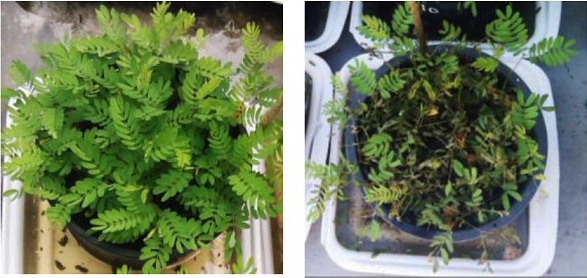ผลของสารสกัดจากต้นหมอน้อย (Vernonia cinerea (L.) Less) ที่มีต่อการแบ่งเซลล์แบบไมโทซิสของรากหอมและการเจริญเติบโตของวัชพืชบางชนิด
Main Article Content
Abstract
Teerarat Chaemchaiyaporn, Teerawat Plairahan and Supaporn Soninta
รับบทความ: 8 สิงหาคม 2560; ยอมรับตีพิมพ์: 19 พฤศจิกายน 2560
บทคัดย่อ
การทดสอบผลของสารสกัดจากต้นหมอน้อย (Vernonia cinerea (L.) Less) สดและแห้งที่มีต่อการแบ่งเซลล์แบบไมโทซิสที่ปลายรากหอมและการเจริญเติบโตของวัชพืช 2 ชนิดคือ ต้อยติ่ง (Ruellia tuberosa L.) และกระถิน (Leucaena leucocephala (Lam.) de Wit) พบว่า สารสกัดจากต้นหมอน้อยด้วยน้ำกลั่นที่อัตราส่วน 1:10 1:20 และ 1:40 กรัม/มิลลิลิตร มีผลทำให้ความยาวของปลายรากหอมลดลงและมีผลยับยั้งการแบ่งเซลล์แบบไมโทซิสที่ปลายรากหอม สารสกัดจากต้นหมอน้อยแห้งทำให้รากหอมมีความยาวเฉลี่ยน้อยกว่าสารสกัดจากต้นหมอน้อยสดในทุกความเข้มข้น โดยเฉพาะที่อัตราส่วน 1:10 มีความยาวรากเฉลี่ยเท่ากับ 0.5 เซนติเมตรและส่งผลทำให้ค่าดัชนีการแบ่งเซลล์ (MI) ลดลงมากที่สุด เหลือเพียง 36.21% เมื่อเปรียบเทียบการออกฤทธิ์ของสารสกัดระหว่างต้นสดและต้นแห้ง พบว่า สารสกัดจากต้นแห้งมีแนวโน้มการออกฤทธิ์ยับยั้งการแบ่งเซลล์ในรากหอมได้ดีกว่าสารสกัดจากต้นสด สำหรับผลการทดสอบสารสกัดจากต้นหมอน้อยแห้งด้วยน้ำกลั่นต่อการงอกและเจริญเติบโตของต้อยติ่งและกระถินในจานเพาะเลี้ยง พบว่า สารสกัดจากหมอน้อยที่อัตราส่วน 1:10 และ 1:20 ยับยั้งการงอกของเมล็ดต้อยติ่งได้อย่างสมบูรณ์และที่อัตราส่วน 1:40 มีเฉพาะรากที่งอกออกมาจากเมล็ด แต่ในเมล็ดกระถินพบว่า สารสกัดที่อัตราส่วน 1:10 มีผลยับยั้งการงอกได้ดีที่สุด รองลงมาคืออัตราส่วน 1:20 และ 1:40 ตามลำดับ โดยมีร้อยละการงอกของเมล็ดเท่ากับ 13.16 31.58 และ 47.37 ตามลำดับเมื่อเทียบกับชุดควบคุม ส่วนผลของการพ่นสารสกัดจากต้นหมอน้อยให้กับต้นกล้าต้อยติ่งและกระถินในกระถาง พบว่า สารสกัดที่อัตราส่วน 1:10 ทำให้ต้อยติ่งและกระถินมีร้อยละการรอดชีวิตน้อยที่สุดโดยมีร้อยละการรอดชีวิตเท่ากับร้อยละ 49.11 และ 63.33 ตามลำดับ นอกจากนี้สารสกัดจากต้นหมอน้อยแห้งทุกอัตราส่วนมีผลยับยั้งการเจริญเติบโตด้านความยาวของลำต้นและความยาวรากของต้นต้อยติ่งและกระถิน และยังมีผลต่อปริมาณคลอโรฟิลล์ เอ คลอโรฟิลล์ บี และคลอโรฟิลล์รวมด้วย จากการทดลองจะเห็นได้ว่า สารสกัดจากต้นหมอน้อยมีประสิทธิภาพในการยับยั้งการแบ่งเซลล์และการเจริญเติบโตของพืชมากขึ้น เมื่อระดับความเข้มข้นของสารสกัดเพิ่มขึ้น
คำสำคัญ: ต้นหมอน้อย ไมโทซิส การยับยั้ง การเจริญเติบโต วัชพืช
Abstract
Inhibitory effects of fresh and dried Little Iron Weed (Vernonia cinerea (L.) Less) water extracts on onion root mitotic cell division and seedling growth of Ruellia tuberosa L. as well as Leucaena leucocephala (Lam.) de Wit were conducted under laboratory conditions. The water extracts at the ratios of 1:10, 1:20 and 1:40 g/mL affected onion root length and mitotic cell division (MI). The dried plant extracts provided higher inhibitory effects than the fresh ones at 1:10 ratio. In addition, onion root length was reduced to 0.5 cm, and the mitotic index was decreased to 36.21%. The dried little iron weed water extracts at 1:10 and 1:20 ratios completely inhibited Ruellia seed germination, while the 1:40 ratio inhibited shoot growth, only root that emerged from the seeds. In Leucaena, the little iron weed extracts at 1:10, 1:20 and 1:40 ratios decreased seed germination to 13.16, 31.18 and 47.37% of control, respectively. In the foliar application tests of the dried little iron weed extracts to Ruellia and Leucaena seedlings, it was found that the 1:10 ratio extract showed the highest toxicity to both seedlings which decreased survival percentages to 49.11 and 63.33% in Ruellia and Leucaena, respectively. The extracts also inhibited shoot and root lengths and decreased chlorophyll a, chlorophyll b and total chlorophyll contents of both test weeds, particularly at the high extraction ratios.
Keywords: Vernonia cinerea (L.) Less, Mitosis, Inhibition, Growth, Weed
Downloads
Article Details

This work is licensed under a Creative Commons Attribution-NonCommercial 4.0 International License.
References
Ali, H. H., Tanveer, A., Nadeem, M. A., Javaid, M. M., Kashif, M.S., and Chadhar, A. R. (2013). Allelopathic effects of Rhynchosia capitata on germination and seedling growth of mungbean. Planta Daninha 31(3): 501–509.
Chatiyanon, B., Phornphisutthimas, S. and Wongwattana, C. (2014). Effects of water extracts from Hemigraphis alternata (Burm. f.) T. Anderson on seed germination and growth of Raphanus sativus L. var. longipinnatus L.H. Bailey and Oryza sativa L. Journal of Research Unit on Science, Technology and Environment for Learning 5(1): 94–100. (in Thai)
Elisante, F., Tarimo, M. T., and Ndakidemi, P. A. (2013). Allelopathic effect of seed and leaf aqueous extracts of Datura stramonium on leaf chlorophyll content, shoot and root elongation of Cenchrus ciliaris and Neonotonia wightii. American Journal of Plant Sciences 4(12): 2332–2339.
Fachinetto, J. M., Bagatini, M. D, Silva, A. C. F., and Tedesco, S. B. (2007). Cytotoxic effects of infusions (tea) of Solidago microglossa DC. (Asteraceae) on the cell cycle of Allium cepa. Brazilian Journal of Pharmacognsosy 19(2B): 632–636.
Gadano, A., Gurni, A., López, P., Ferraro, G., and Carballo, M. (2002). In vitro genotoxic evaluation of the medicinal plant Chenopodium ambrosioides L. Journal of Ethonopharmacology 81(1): 11–16.
Hopkins, W. G., and Hüner, N. P. A. (2003). Introduction to Plant Physiology. 3rd ed. New York: Wiley.
Moran, R. (1982). Formulae for determination of chlorophyllous pigments extracted with N,N-dimethylformamide. Plant Physiology 69(6): 1376–1381.
Rice, E. L. (1984). Allelopathy. 2nd ed. Orlando: Academic.
Rizvi, S. J. H., and Rizvi, V. (1992). Allelopathy: Basic and Applied Aspects. London: Chapter & Hall.
Yan, Z. Q., Wang, D. D., Ding, L., Cui, H. Y., Jin, H., Yang, J. S., and Qin, B. (2015). Mechanism of artemisinin phytotoxicity action: Induction of reactive oxygen species and cell death in lettuce seedlings. Plant Physiology and Biochemistry 88: 53–59.
